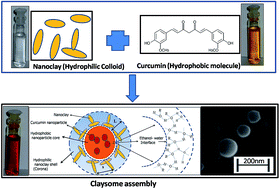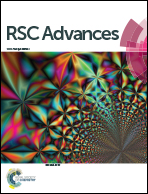Self-assembly of synthetic liposome-like curcumin nanoparticles†
Abstract
The self-assembly of curcumin nanoparticles has gained considerable attention due to their widespread applications in the biological and technological fields. We report the formation of free-energy-driven self-assembled core–shell curcumin nanoparticles. The assembly mimics the morphology of liposome with hydrophobic curcumin particles trapped inside the core and hydrophilic nanoclay platelets forming the corona. Hydrophilic and hydrophobic regions were found to coexist with a soft interface separating them. Herein, a simple theoretical model is used to explain the important role played by the interface in providing stability to the assembly, whereby it provides a repulsive barrier against the attractive hydrophobic forces prevailing between the nanoparticles located in the core. The dimension of the nanoclay platelets beautifully tunes the stability of the self-assembly. It is remarkable that hydrophilic and hydrophobic systems can coexist with soft interfacial forces providing the required stability without the necessity for any surfactant.



 Please wait while we load your content...
Please wait while we load your content...